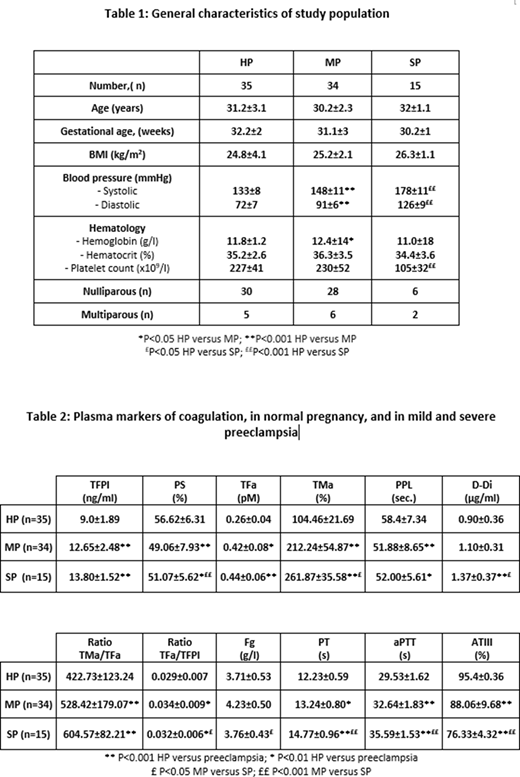Introduction:Different coagulations abnormalities have been referred in women with early oncet preeclampsia (EOP), but there are only few studies comparing those changes regarding to the severity of the disease.
Aim:In this study we aimed to investigate the differences between the coagulation profile in women with mild and severe preeclampsia.
Methods:This is an observational retrospective case-control study. Plasma samples were collected from 84 women divided into three groups, the healthy pregnant (HP) group (n=35), the mild preeclampsia (MP) group (n=34) and the severe preeclampsia (SP) group (n=15). The study population general characteristics are shown in Table 1. We studied the following biomarkers of hypercoagulability and endothelial cell activation: Tissue factor activity (TFa), Procoagulant phospholipid activity (PPL), Protein S, D-Dimers, Antithrombin, thrombomodulin, TFPI levels. All women were assessed with classic coagulation tests (aPTT and PT) fibrinogen levels and hemogram. Statistical analysis was performed using the PASW Statistics 17.0.2 (SPSS Inc.) for Windows.
Results:Women with preeclampsia - mild or severe- showed significant increase of TFPI, TFa and TMa levels as compared to healthy pregnant women. No significant difference of TFPI, TFa was observed between MP and SP groups. In contrast, TMa levels were significantly increased in SP as compared to MP group. The ratio TFa/TFPI was also lower in SP as compared to MP-group. Women in MP or SP group had similarly shorter PPL clotting time as compared to HP group. D-dimer levels were increased in women with preeclampsia as compared to the HP group. D-Dimer levels were significantly higher in SP as compared to MP group. The levels of free PS activity in HP as well as MP and SP groups were lower than normal range in non-pregnant women and the value in MP was significantly lower than that of the HP or SP. Fibrinogen levels were not significantly different in the three studied groups of pregnant women. Prothrombin time was found to be increased in cases as compared to that in the controls. The mean value of prothrombin time in mild preeclampsia was 13.24±0.80 seconds and in severe preeclampsia it was seconds 14.77±0.96 and in pregnant controls 12.23±0.59 seconds (p<0.05 and p<0.001 respectively). The mean prothrombin time was found to increase with increasing severity of disease (p<0.001). The mean activated partial thromboplastin time were increased in mild preeclampsia and was 32.64±1.83 seconds and in severe preeclampsia it was 35.59±1.53 seconds and in pregnant controls 29.53±1.62 seconds (p<0.001). The activated partial thromboplastin time was found to increase with increasing severity of disease (p<0.001). The antithrombin III decreased in severe SP and MP or compared to pregnant controls (76.33±4.32 and 88.06±9.68 versus 95.40±0.36 respectively; p<0.001). This decrease is more pronounced in SP compared to MP (p<0.001).
Conclusions:Preeclampsia is associated with endothelial cell activation as documented by the increase of TFa, soluble TM levels and TFPI levels in plasma. Release of soluble thrombomoduline and TFPI rather than TFa by endothelial cells appear to be related with degree of preeclampsia severity. Women with preeclampsia showed marked decrease of PPL clotting time indicating enhanced platelet activation that was independent of the severity of preeclampsia. In contrast, women with severe preeclampsia showed signs of enhanced hypercoagulability documented by the increase of D-dimer levels consumption of natural coagulation inhibitors and particularly of AT. This phenomenon tended to be reflected on the prolongation of PT and aPTT in women with severe preeclampsia.
No relevant conflicts of interest to declare.
Author notes
Asterisk with author names denotes non-ASH members.


